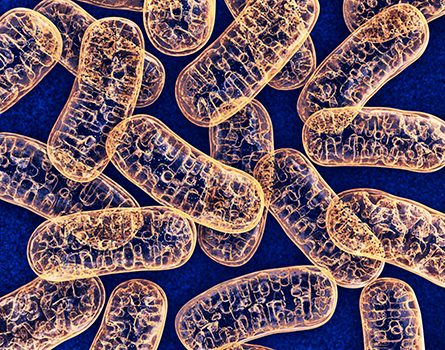A balancing game with implications for neurodegenerative disease
Mitochondria in healthy cells have a stable balance of fission and fusion, the processes by which these cellular organelles divide and merge. Mitochondrial DNA is essential for their proper function, and mitochondrial fusion can help overcome genetic malfunctions and recycle proteins of nonfunctioning mitochondria in the cell. While researchers still have many questions about mitochondrial fission and fusion, we know these processes are particularly important in the brain and nerves, and recent studies suggest that mitochondrial fission and fusion are altered in several neurodegenerative diseases including Alzheimer’s.

Ken Nakamura, a professor at the Gladstone Institute of Neurological Disease at the University of California, San Francisco, focuses his research on cellular mitochondrial function and association with neurological disease. In a recent paper in the Journal of Biological Chemistry, Lauren Shields, then a grad student, and a team from the Nakamura lab describe research into how mitochondrial fission is related to the toxicity of a key Alzheimer’s disease protein, amyloid-beta precursor protein, or APP. Shields, who was always interested in the neurosciences field, pushed the lab beyond its previous focus on Parkinson's disease and remembers that she was the "first graduate student to venture into Alzheimer's."
The research focused on understanding the role of dynamin-related protein 1, or Drp1, an essential mitochondrial fission protein that is increased in the brain tissue of Alzheimer’s disease patients and may be associated indirectly with metabolism of the calcium ions, or Ca2+, in the cell.
“Mitochondria are unusual organelles,” Shields said. “This all goes back to the theory of evolution that mitochondria were bacteria-like and were encompassed by cells … they’ve maintained this fission and fusion function.”
The researchers studied mice that were genetically altered to express mutant human APP, known as hAPP mice, with a targeted deletion of Drp1 that prevented fission in mitochondria. They found that the Drp1 knockout intensified the spatial learning and memory impairments observed in the hAPP mice.
Shields and the team also found that the loss of Drp1 combined with mutant hAPP to produce mitochondrial Ca2+ overload, possibly due to excessive influx of Ca2+ from the cytosol into mitochondria. They concluded that mitochondrial fission may be a protective mechanism against mitochondrial Ca2+ overload, which may be an initiating factor in the cascade of toxic insults that combine to cause neuronal dysfunction and degeneration in Alzheimer’s disease.
This work clearly shows the need for the delicate balance of mitochondrial fusion and fission in healthy cells. Because Drp1 is known to be increased in post-mortem Alzheimer’s disease patient tissue, the team originally had hypothesized that Drp1 could be a good therapeutic target. However, they concluded that Drp1 actually would be a risky target, given the need for careful calibration of the fission–fusion balance and Drp1’s protective role in Ca2+ homeostasis.
“A lot of what my time in the neurodegenerative field really underscored for me is how complex humans are, how complex the brain is and how complex neurodegenerative cascades are,” Shields said. “This is one more small piece of that big story.”
Enjoy reading ASBMB Today?
Become a member to receive the print edition monthly and the digital edition weekly.
Learn moreGet the latest from ASBMB Today
Enter your email address, and we’ll send you a weekly email with recent articles, interviews and more.
Latest in Science
Science highlights or most popular articles

Genetics studies have a diversity problem that researchers struggle to fix
Researchers in South Carolina are trying to build a DNA database to better understand how genetics affects health risks. But they’re struggling to recruit enough Black participants.

Scientists identify new function of learning and memory gene common to all mammalian brain cells
Findings in mice may steer search for therapies to treat brain developmental disorders in children with SYNGAP1 gene mutations.

From the journals: JBC
Biased agonism of an immune receptor. A profile of missense mutations. Cartilage affects tissue aging. Read about these recent papers.

Cows offer clues to treat human infertility
Decoding the bovine reproductive cycle may help increase the success of human IVF treatments.

Immune cells can adapt to invading pathogens
A team of bioengineers studies how T cells decide whether to fight now or prepare for the next battle.

Hinton lab maps structure of mitochondria at different life stages
An international team determines the differences in the 3D morphology of mitochondria and cristae, their inner membrane folds, in brown adipose tissue.

